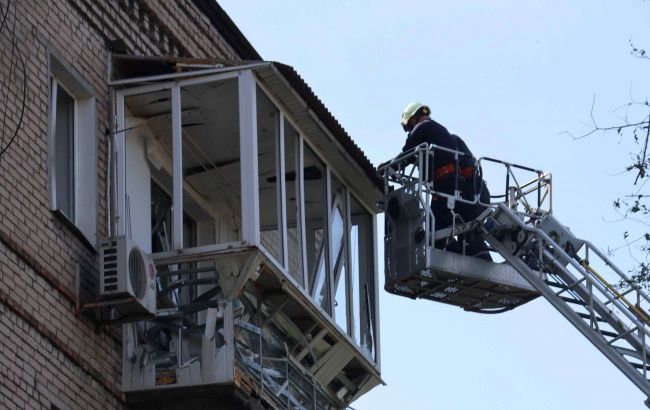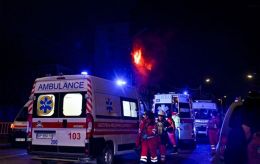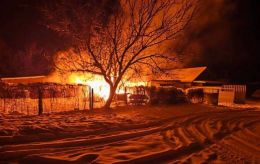Russia shifts focus to southern Ukraine? Why guided bombs hit Zaporizhzhia and what targets Moscow sets
 Photo: rescuers at the site of the strikes in Zaporizhzhia (facebook.com/DSNSZP)
Photo: rescuers at the site of the strikes in Zaporizhzhia (facebook.com/DSNSZP)
Russian forces have begun striking Zaporizhzhia with guided aerial bombs (GABs). As a result, over a hundred buildings have been damaged, dozens of civilians injured, and there is one confirmed fatality.
For more on why Russia has started using GABs and its objectives in Zaporizhzhia, read the report below.
Contents:
- What is known about the strikes on Zaporizhzhia
- What Russia uses
- Why now and what are the targets
- How to protect Zaporizhzhia from guided bombs
What is known about the strikes on Zaporizhzhia
Russian forces first attacked Zaporizhzhia with GABs on the evening of September 22. Between 10:19 PM and 11:04 PM, both the regional center and a village in the Zaporizhzhia district were targeted. A total of seven strikes were recorded.
The bombs hit civilian infrastructure, damaging 40 apartment buildings, 10 non-residential buildings and premises, two educational institutions, and several vehicles in the Voznesenivskyi and Dniprovskyi districts. The blast wave also shattered windows in nearby buildings.

Photo: aftermath of the attack on Zaporizhzhia (t.me/ivan_fedorov_zp)
As a result, over 20 people were injured, with 13 women and 8 men seeking medical assistance. After examination and first aid, most were discharged, but two women with blast injuries remain hospitalized in moderate condition.
On the evening of September 23, Russian forces launched another massive strike on Zaporizhzhia, targeting critical infrastructure and residential areas.
According to Ivan Fedorov, head of the Zaporizhzhia Regional Military Administration, the enemy carried out six airstrikes using GABs, damaging over 70 apartment buildings and other structures in three districts.
As a result of the strike, a private house in the Shevchenkivskyi district was completely destroyed. A 47-year-old man was killed, and his elderly mother was injured. In the same district, a yard in a residential area was also hit, injuring a teenager. In the Komunarskyi district, a 13-year-old girl was wounded. In total, nine people were reported injured on Monday.
What does Russia use
Analysts from the Institute for the Study of War (ISW) highlight reports that Russian forces did not use precision-guided bombs but rather FAB-250 high-explosive bombs equipped with Unified Planning and Correction Modules (UMPK).
The Soviet-era FAB variants are mostly unguided. It remains unclear whether the bombs dropped on Zaporizhzhia were equipped with guidance systems, but the addition of UMPK turns standard FAB bombs into guided munitions capable of hitting targets at a greater distance.
These bombs have a range of 40-60 km, according to ISW. In September, Russia increased the number of strikes on southern suburbs 15-20 km from Zaporizhzhia, often from temporarily occupied areas near Tokmak and Vasylivka. Strikes on the city center were inevitable.
There have been reports that Russia has been working to improve its guided bombs for greater range. However, military expert and former Ukrainian General Staff spokesperson Vladyslav Seleznov doubts that any special bombs are being used to strike Zaporizhzhia.
"Zaporizhzhia is about 30 km from the frontline. Can Russian bombs reach that distance? Of course, because they can definitely work at 30 km. Russian guided bombs are often not very precise and frequently hit residential areas, but the enemy is using all available resources to cause maximum damage," Seleznov said.

Photo: An unexploded FAB-500 on the outskirts of Zaporizhzhia (facebook.com/DSNSZP)
The day before, rescuers discovered an unexploded FAB-500 near Zaporizhzhia. Military expert Mykhailo Zhyrokhov emphasized that Russia is advancing, using FAB-500T bombs with improved aerodynamics, allowing them to fly farther. Additionally, the UMPK system is evolving, with better electronics and larger wings. "Therefore, Zaporizhzhia is now clearly within the reach of these bombs," he said in a comment to RBC-Ukraine's YouTube channel.
Why now and what are the targets
According to Seleznov, the primary targets are likely industrial facilities involved in the production of missile weapons and other equipment for Ukraine's defense forces.
"The enemy is trying to destroy these enterprises. Where they can reach with bombs, they use them. Where they can't, they use Iskander missiles, North Korean missiles, or S-300/S-400 systems. The goal is to weaken our military potential, which is nothing new," Seleznov explained.
He cited the Motor Sich plant as an example, which has been repeatedly hit by ballistic missiles during the full-scale war. The day before, a video was posted on Russian social media showing the aftermath of strikes on an alleged “workshop for the production of components for drones.” Although Ukraine has not officially confirmed the latest strike on the plant, it’s noteworthy that it is located in the Shevchenkivskyi district, which was recently hit by bombs.
Why are the Russians using guided bombs now? One reason might be their awareness of the lack of air defense systems in the Zaporizhzhia area.
"If there were a Patriot or SAMP/T battery near Zaporizhzhia, it would cover airspace up to 120 km, making it impossible for planes to drop bombs. Most likely, such systems are not there. I can't say for sure, but if they were, Russian planes would be shot down rather than dropping bombs," the expert said.
The ISW report also notes that some Russian military bloggers believe the recent strikes on Zaporizhzhia indicate a shift in combat capabilities, potentially signaling future strikes on logistical sites near the regional center and bridges across the Dnipro River.
However, Seleznov pointed out that the enemy will not be able to destroy bridges with guided bombs. There may be some damage, but there is no question of destruction by a guided bomb.
"It’s an operational issue and the issue of scale of the application. I doubt the enemy has such capabilities. But the fact that they are attacking more frequently suggests that in the near future, after completing their tasks in the east around Vuhledar, Selydove, and Toretsk, they may shift focus to the south, including the Zaporizhzhia direction. According to their constitution, it is 'Russia, and they will try to capture territories. This foundation is being laid now," he added.
How to protect Zaporizhzhia from guided bombs
Guided aerial bombs are launched from aircraft such as the Su-34 and Su-35. To deploy GABs, these planes must approach within a certain distance to avoid the reach of Ukraine's short-range air defense systems.
Experts and military personnel consistently state that once a GAB is launched, it is nearly impossible to intercept in mid-air. The best countermeasure is to target and shoot down the launching aircraft. This highlights the urgent need for Ukraine to enhance its air defense capabilities along the front lines and in nearby rear areas.
However, it is possible to fight not only by strengthening air defense. A second option is to destroy Russian aircraft at their bases, explains military expert Vladyslav Seleznov.
"Currently, reports suggest that these aircraft are stationed more than 300 km away. But I think this information may not be fully verified," he noted.
According to him, most bombers used for launching GABs operate at distances of up to 600 km. This implies roughly 300 km in one direction and 300 km for the return trip.
"Consequently, the enemy has limited maneuverability. Therefore, I believe that the operational airfields used for strikes on Zaporizhzhia are located in temporarily occupied Crimea and the Rostov region. These are within the reach of missiles we possess from our Western partners. The only questions are about permissions and the sufficient quantity of missiles. It is possible to protect Zaporizhzhia from GABs; it just requires the political will of our partners and resource support," he concluded.
Sources: police reports, the State Emergency Service information, comments from the head of the Zaporizhzhia Regional Military Administration Ivan Fedorov, and analysis reports from the Institute for the Study of War (ISW), along with comments from military expert Vladyslav Seleznov.

